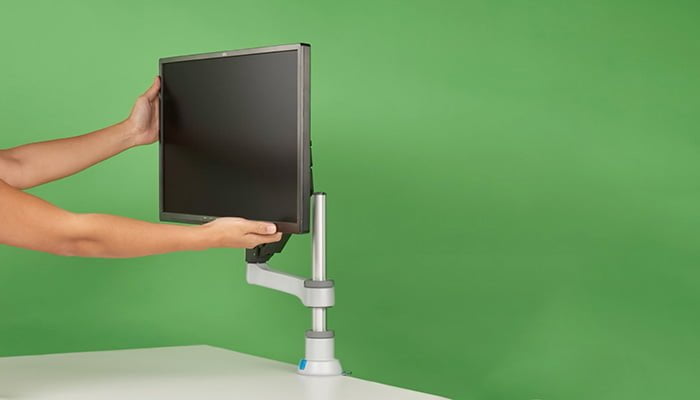Do you work with a desktop? Then you probably have a fixed workstation. The advantage of having your own workstation is that you can adjust the screen completely to your own needs and body dimensions. With the right settings, you will imperceptibly adopt a healthy posture. But how do you accomplish that?

Tips for positioning your monitor
Place the monitor right in front of you.
This keeps you sitting upright unnoticed.
Make sure the top of the screen is at eye level.
This allows you to look slightly down while working, which ensures a natural and relaxed position of your head.
Position the monitor at the correct viewing distance.
The recommended viewing distance, measured from the eyes to the screen, is 50 to 70 cm. Note that this also depends on the size of your screen and characters.
Adjust screen settings such as colour and resolution.
For example, choose dark letters on a light (white) background, as you are used to from paper. Also check the resolution of your screen. Higher resolutions give sharper details. However, this makes the characters smaller, which can quickly lead to eye fatigue and provoke a hunched posture.
Avoid annoying reflections in the screen.
Place the screen at right angles to the window. This prevents reflections and large light contrasts. In addition, choose a matt screen instead of a glossy one. A shiny screen easily shows reflections, which also causes eye strain.
Work sensibly with 2 screens.
The larger the screens, the greater the risk of unfavourable turning movements of the neck. A viewing angle of 0 – 30 degrees is still acceptable. Therefore, place your screens within this viewing angle and at the same height. Use one screen as the main screen as much as possible. Place the second screen right next to the main screen. If your so-called ‘dominant eye’ is on the left, place the second screen to the left of the main screen (and vice versa). This way, you imperceptibly turn your head less.
Solutions for the desktop
A standard monitor has minimal or no height adjustment. Placing it too low can cause back and neck pain. To adjust the monitor correctly to your body dimensions and working posture, it is therefore best to use a monitor riser or a monitor arm.
Monitor riser (or stand)
A monitor raiser, as the name suggests, is only meant to raise the screen. These raisers are available in two variants: with a fixed height or (limited) adjustable height.
Monitor arm
A monitor arm is height-adjustable and can also rotate, tilt and move the screen in depth. The simplest monitor arms adjust once, which is sufficient for a personal workstation. Gas-sprung monitor arms are also available that can easily and quickly adjust the screen (or several screens) to any desired position. These arms are ideal for flexi workstations.
More about monitor arms?
Do you want to know what the best solution is for your workplace? Or are you curious about your dominant eye? You can read more about it in our white paper. Download below!


